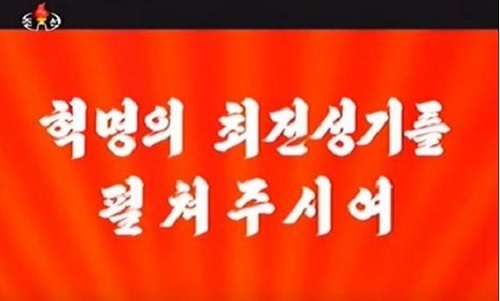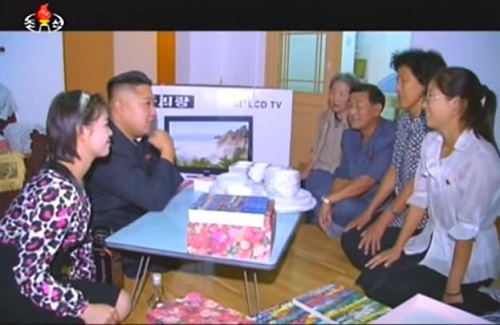Six years into his reign as leader, Kim Jong Un has made clear that he intends to follow in his father’s footsteps by using documentary films to promote the Kim family’s cult of personality. Beginning with the publication of a 1973 treatise entitled, “On the Art of Cinema,” Kim Jong Il regularly used films to promote the regime’s idolization efforts, and it is becoming increasingly apparent that Kim Jong Un favors the same medium for the same purpose.
Beginning in October last year, the regime has been repeatedly broadcasting a documentary entitled “Unfurl the Heyday of the Revolution,” at various events and conferences. The film details a stream of Kim’s ‘accomplishments,’ including on-the-spot guidance at military bases and food factories, the ‘200-Day Battle’ labor mobilization, various missile launches, and a visit to a seafood processing plant. According to the Rodong Sinmun, North Korea’s party-run publication, the film was first unveiled on October 22 at the 7th Conference of the General Federation of Korean Trade Unions.
Thereafter, the movie was screened at various political meetings including the 6th Conference of the Socialist Women’s Union of Korea (f.k.a. Korean Democratic Women’s Union) in November, the 8th Conference of the Union of Agricultural Workers of Korea in December, and a meeting of the heads of district-level Workers’ Party of Korea (WPK) organizations in December.
The documentary film asserts that in the short time since coming to power, Kim Jong Un has led the party, the military, and the people in revolutionary changes that have developed the socialist strength of the nation in terms of the economy, politics, defense, and culture. According to analysts, the film’s intention is to set the groundwork for idolization of the young leader, and numerous documentary films of the same nature can be expected in the years to come.
Konkuk University Professor Kim Seung noted, “It appears that the North Korean leadership has concluded that documentary films are more effective propaganda tools than art films. Art films have declined in popularity among the general public, and documentary films are cost effective to produce, so we will likely see more in the future.”
Another North Korea expert added on condition of anonymity, “Compared to past documentaries coming out of the North, this film is more slick. You can tell they put hard work into producing it. Whenever the authorities need a propaganda movie to show in future, whether it’s at a conference or a political event, they will likely show this.”
The differences between the latest documentary and films made during the Kim Jong Il and Kim Il Sung eras show a stark difference. The new film is similar to its predecessors in that it aims to buttress the regime’s stability by promoting idolization of the leader, but the filming techniques are notably different.
“During the Kim Il Sung and Kim Jong Il era, they did not do profile shots or backshots of the leader. But in the new documentary, there are high angle shots, side shots, and following shots of Kim Jong Un. In previous times, these kinds of viewpoints were unthinkable.” Professor Kim explained.
The film opens with a shot of Kim Jong Un standing alone on a mountain top, rising from the clouds. It is a solemn depiction of the leader, no doubt intended to promote his deification. Following the scene, an explanation of how Kim is bringing about a new golden era of revolution is given.
The documentary film fits into a long tradition of the Kim family using movies, novels, and art in order to promote their stature and recount their often fabricated accomplishments.
The female narrator of the film explains, “The affectionate Suryong [Kim Il Sung] lives on through the Marshal [Kim Jong Un] and in this way, his accomplishments have continued without interruption. Kim Jong Un, as heir, is a shining light who is trusted with safeguarding and improving the immortal revolutionary deeds of these great leaders who came before him.” In this way, the film explains the Kim family’s accomplishments and justifies Kim’s rightful place as heir to the Kim family dynasty.
In one scene, Kim Jong Un and his wife, Ri Sol Ju, visit a family’s home to give them expensive gifts like an Arirang LCD TV. This scene epitomizes the Kim style of rule, in which misdeeds are punished and contributions are rewarded. The use of gift-giving to inspire loyalty is a continuation of policies pursued by both Kim Jong Il and Kim Il Sung.
In a bid to justify Kim Jong Un’s ascension to the throne, a number of scenes referencing previous Kim family leaders are interspersed throughout the film. The leaders are seen appearing in public to the warm cheers of onlookers. The documentary seeks to portray Kim Jong Un as the legitimate heir who is continuing the revolutionary struggle in response to the people’s demand.
The final scenes of the film summarize the film’s overall message, showing pictures of the three leaders together and a parade with a float that says, “All of society will advance Kimilsungism-Kimjongilism!” while Kim Jong Un’s name is spelled out in cards.
In commenting on the film, a Unification Ministry official noted, “Kim Jong Il tried to defend his legitimacy by emphasizing the Mount Paektu bloodline, much like his father Kim Il Sung did. Kim Jong Un claims to be able to stand on his own, but he doesn’t have many accomplishments to his name yet, so he uses the bloodline reason instead to claim authority.”
According to The 20th Century North Korean Arts and Culture Dictionary (a publication by the University of North Korean Studies), normal documentary pictures are intended to naturally portray real life events and facts.
However, the documentary films produced by the North Korean authorities have a single purpose – to serve as ideological tools for the leadership. Even the regime itself makes a candid admission, stating that, “Documentaries produced by the exclusively legitimate system help promote the socialist revolution and the leader’s achievements.”





















